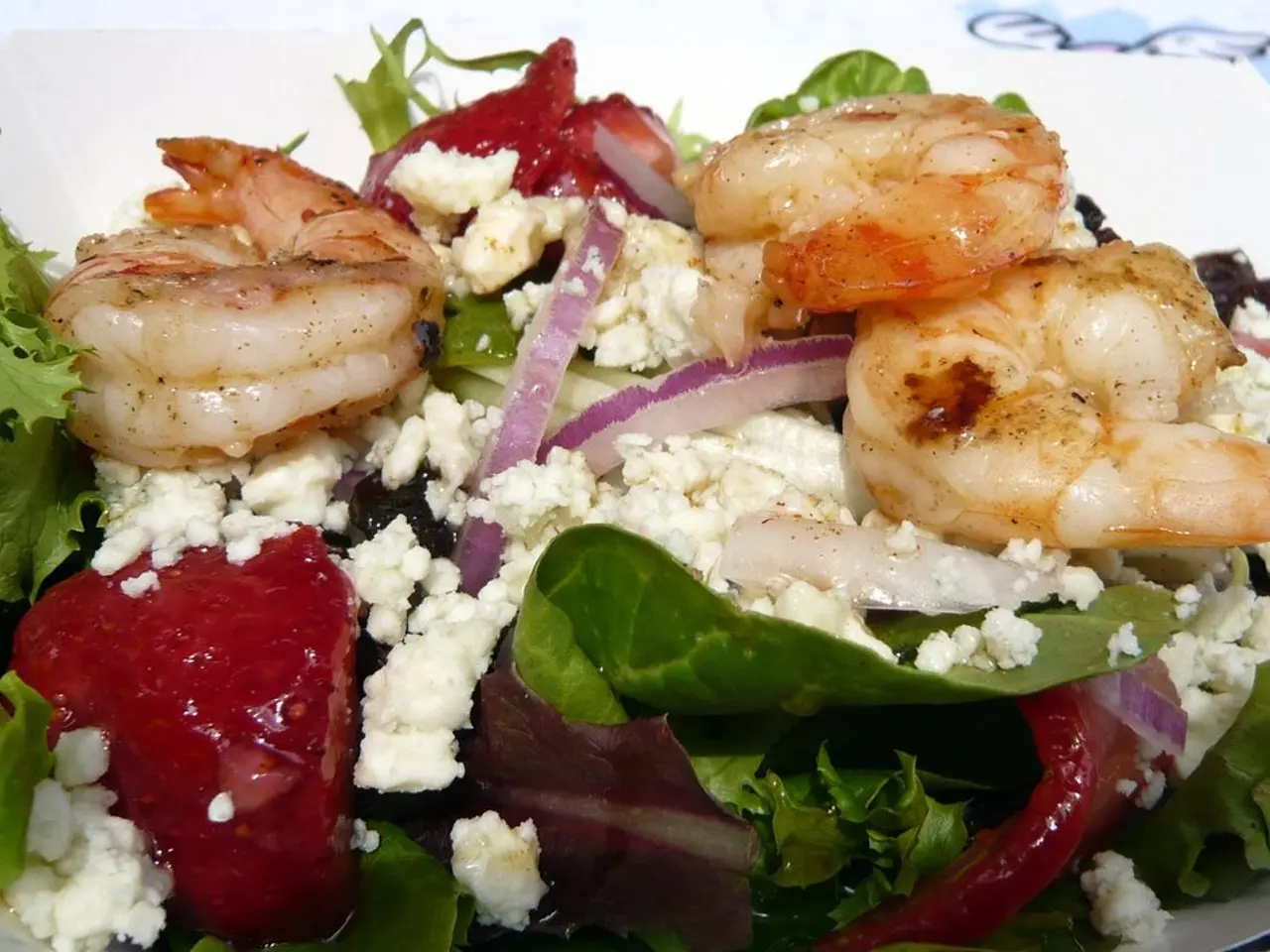Freshwater Aquaculture Profit and Sustainability: Capitalizing on the Potential of the Colossal River Prawn
In the vast and diverse landscape of Indian aquaculture, a new player has emerged - the Giant River Prawn, locally known as Scampi. This culinary delicacy is not only a treat for the palate but also a reliable source of livelihood for thousands of farmers across the country.
Pond Preparation and Stocking
The process of Scampi farming begins with preparing a suitable pond. Ideally, a pond of about one acre area with a depth ranging from 1 to 1.5 meters is ideal. The pond is cleaned thoroughly, limed to adjust pH and reduce harmful microbes, and filled with freshwater suitable for the prawn's growth. The pond environment should mimic their natural habitat in slow-moving freshwater bodies.
Once the pond is ready, prawn larvae or post-larvae are stocked at appropriate stocking density, which depends on the management system but aims to optimize growth and minimize competition. Post-larvae stage is preferred as they are ready to adapt to pond conditions.
Feeding and Growth
Feeding is critical as Scampi require protein-rich diets for optimal growth. Farmers use commercial prawn feed or formulated feeds rich in protein and nutrients suited to the prawn's developmental needs. Feeding schedules are maintained regularly to ensure continuous growth. Natural food availability in the pond, such as plankton and detritus, also supports supplementation feeding.
Harvesting and Management
Giant River Prawns typically reach marketable size (25–30 cm or over 200 gm) after about 5 to 6 months. Harvesting is done by draining the pond or using nets in a scheduled manner to collect mature prawns for sale. Harvesting usually occurs during cooler parts of the day to minimize stress and preserve meat quality.
Good management practices can lead to significant profits for farmers. With good management, Scampi farmers can earn a net profit of Rs. 50,000 to Rs. 1,00,000 per cycle. An average 1-acre Scampi pond can yield 600-800 kg of marketable Scampi.
A Sustainable and Lucrative Practice
Scampi farming is environment-friendly when managed well. It is suitable for inland farming as Scampi is native to Southeast Asia and thrives in freshwater environments. The practice is gaining momentum in Indian states like Andhra Pradesh, Odisha, West Bengal, Assam, and Kerala. The prawns fetch premium market prices due to their size and meat quality.
Moreover, the export potential of Scampi is significant, especially to Gulf and Southeast Asian countries. Managing male ratios and controlling aggressive blue-clawed males can improve overall growth in a Scampi pond. Scampi are omnivorous and feed on algae, detritus, small organisms, and commercial feeds with around 30-35% protein content.
Aeration is important for Scampi farming, especially during warm months, to ensure adequate oxygen levels. Feeding should be done early in the morning and evening, and supplementing with farm-made feeds like rice bran, groundnut cake, or boiled broken rice can help reduce costs.
Scampi seed, called post-larvae (PL), is usually purchased from certified hatcheries and stocking density ranges from 4 to 6 PL per square meter. Harvestable Scampi usually weigh between 100-150 grams.
In conclusion, Scampi farming is a sustainable and lucrative practice that is gaining popularity in India. With its potential for domestic and international markets, it offers a promising opportunity for farmers to diversify their income sources and contribute to India's aquaculture sector.
[1] Government of India, Department of Fisheries, Aquaculture Division. (n.d.). Giant Freshwater Prawn Culture. Retrieved from https://fisheries.gov.in/sites/default/files/2019-05/Giant-Freshwater-Prawn-Culture.pdf
[3] Fisheries and Aquaculture Department, Government of West Bengal. (n.d.). Giant Freshwater Prawn (Macrobrachium Rosenbergii) Culture. Retrieved from https://fisheries.wb.gov.in/sites/default/files/2019-05/Giant-Freshwater-Prawn-Culture.pdf
- An entrepreneur in the food-and-drink sector might consider Giant River Prawn farming as a small business opportunity, given its potential for significant profits.
- The practice of Scampi farming, a promising trend in Indian aquaculture, aligns well with the lifestyle of many agricultural entrepreneurs who seek sustainable and lucrative livelihood options.
- As the demand for global cuisines expands, Indian entrepreneurs delving into cooking and restaurants might find Giant River Prawn a valuable ingredient, given its premium market prices and mouthwatering taste.
- A career in Scampi farming could be an interesting option for individuals passionate about business and agricultural practices, as the global market for this culinary delicacy is growing steadily.
- Entrepreneurs interested in sharing culinary expertise and recipes could write a cookbook featuring exotic global cuisines, including dishes made with the succulent Giant River Prawn, offering a unique blend of lifestyle, food-and-drink, and business insights.




